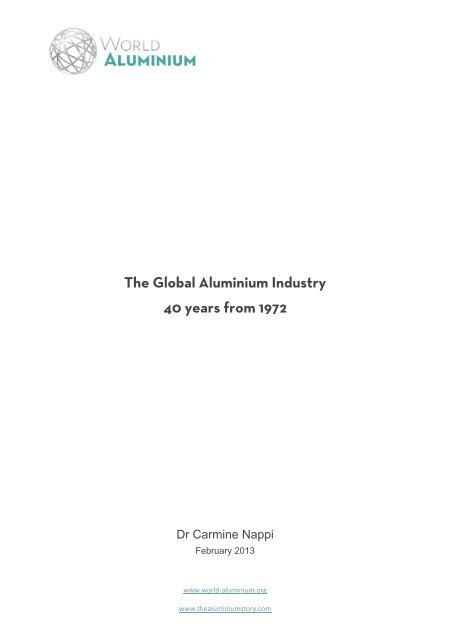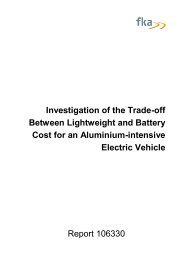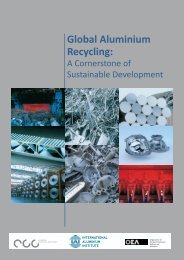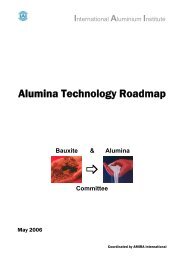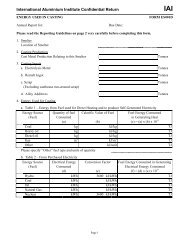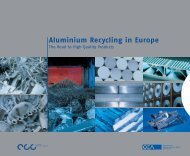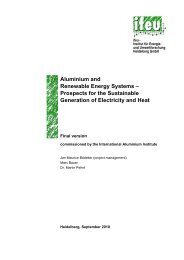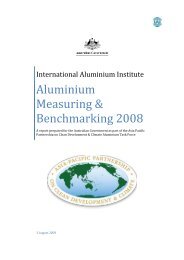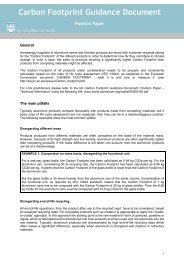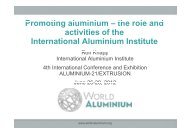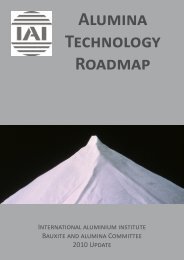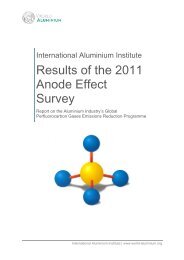The Global Aluminium Industry 40 years from 1972 - International ...
The Global Aluminium Industry 40 years from 1972 - International ...
The Global Aluminium Industry 40 years from 1972 - International ...
You also want an ePaper? Increase the reach of your titles
YUMPU automatically turns print PDFs into web optimized ePapers that Google loves.
<strong>The</strong> <strong>Global</strong> <strong>Aluminium</strong> <strong>Industry</strong><strong>40</strong> <strong>years</strong> <strong>from</strong> <strong>1972</strong>Dr Carmine NappiFebruary 2013www.world‐aluminium.orgwww.thealuminiumstory.com
ForewordIn 2012, the <strong>International</strong> <strong>Aluminium</strong> Institute (IAI)—a global forum for aluminium producersworldwide—celebrated its <strong>40</strong> th year, having been incorporated on 28 April <strong>1972</strong> as the<strong>International</strong> Primary <strong>Aluminium</strong> Institute (IPAI). <strong>The</strong> term “Primary” was deleted in 2000, thechange reflecting a broader, inclusive agenda and commitment to sustainability along the wholeindustry value chain.At the <strong>1972</strong> incorporation, there were 44 member companies; global primary aluminiumproduction was less than 12 million tonnes (Mt). A smelter capacity of over 150,000 tonnes wasconsidered to be large; today 500,000 tonne capacities are commonplace and a number offacilities are at or approaching one million tonnes annual capacity. Currently, the IAI has 26member companies, responsible for around 70% (about 28 Mt) of world primary aluminiumproduction.<strong>The</strong> IAI invited Dr Carmine Nappi, Consultant and <strong>Industry</strong> Analyst, to reflect upon the globalchanges and developments within the aluminium industry over the period of the existence ofthe IAI. <strong>The</strong> contents of this paper reflect the views of Dr Nappi, not the IAI.Dr Carmine Nappi has almost four decades of experience in the metals and mineral economicsindustry. Carmine joined Alcan in May 1999 as Director of <strong>Industry</strong> Analysis and was promotedto the position of Vice President of <strong>Industry</strong> Analysis at Rio Tinto Alcan in November 2007,where he was responsible for price forecasting and analysis of aluminium industry trends.Carmine retired <strong>from</strong> Rio Tinto Alcan in 2011 and is now consulting in the field of industrialorganization.2
1. IntroductionToday, the global aluminium industry has only a bare resemblance to what it was in the early1970s. <strong>The</strong> most important structural changes are the geographical relocation of bauxite,alumina and aluminium production centres; shifts in the degree of concentration andintegration; the emergence of new consuming regions, the development of new end-usemarkets and the threat of substitutes, including recycled metal; the historical decline in realprices of the metal and the recent upward shift in the industry cost curve; the market adjustmentmechanisms and, more recently, the rising popularity of commodities as an asset class.<strong>The</strong> main objective of this paper is to highlight and analyze these changes over the last fourdecades. Commencing with an identification of the main characteristics of the aluminiumindustry in the early 1970s, the paper then examines the main forces or drivers that havedeeply modified the structure of the global aluminium industry, factors such as energy crises,arrival of new players, variations in exchange rates, shifting trends in aluminium cost curves,and the role of emerging economies. <strong>The</strong> main characteristics of current global aluminiumindustry are then presented, with a view on future demand and production.2. <strong>The</strong> <strong>Global</strong> <strong>Aluminium</strong> <strong>Industry</strong> in the Early 1970s<strong>The</strong> year <strong>1972</strong> saw bauxite production dominated by four countries — Australia, Jamaica,Suriname and USSR — which together held a 60% global market share. Today, only Australiais on a list of the top six producers. Even greater changes have occurred in the location ofalumina-producing countries. In <strong>1972</strong>, more than 45% of global alumina production wasconcentrated in five industrialized countries, poorly-endowed with bauxite reserves: UnitedStates, Japan, Canada, France and Germany. <strong>The</strong> other major producers were then Australia(13%), USSR (12%), Jamaica (9%) and Suriname (6%). Today, among the countriesmentioned above, only Australia is still a significant producer, with alumina production havinggenerally shifted <strong>from</strong> industrialized or aluminium producing countries to bauxite producingregions.Major shifts have also occurred in the geographic location of aluminium production centres. <strong>The</strong>combined share of United States, USSR and Japan reached almost 60% of global primaryproduction in <strong>1972</strong>. Today, their corresponding share barely exceeds 10%. Norway, Germanyand France have also been replaced on the list of top aluminium producers. This relocation ofbauxite, alumina and aluminium production centres has been accompanied over the last <strong>40</strong><strong>years</strong> by other significant structural and behavioural changes that need to be analyzed.3
Degree of concentration and integration1955 1971 19792% 12%5%28%37%19%23%Bauxite11%CR6 : 88.2 %HH : 0.187CR6 : 63.5 %HH : 0.08614%46% CR6 : 54.4 %HH : 0.0768%16%26%2%5%12%11%4% 4%8%7%5%4% 10%25%21%23%26%28%Alumina12%17%CR6 : 90.6 %HH : 0.18427%3%11%12%CR6 : 79.2 %HH : 0.12911%19%5%9%CR6 : 73.8 %HH : 0.1239%9%14%Primary <strong>Aluminium</strong>4%6%15%14%CR6 : 85.9 %HH : 0.15915%20%26%6%27%10%CR6 : 73.0 %HH : 0.1038%17%12%20%38%6%8%15%CR6 : 62.2 %HH : 0.0748%9%16%46%Alcoa 24%7% 5% 8% 8%5%Alcan Reynolds Kaiser Pechiney Alusuisse OthersFigure 2: Market Shares and Degree of Concentration 1 in <strong>Global</strong> Bauxite, Alumina, & Primary Capacities: 1955, 1971, 1979Source: Derived <strong>from</strong> John A Stuckey, Joint Ventures and Vertical Integration in the <strong>Aluminium</strong> <strong>Industry</strong>,Harvard University, Cambridge, 1983, p.841Measured by share of the six most important companies (CR6) and HH index (sum of squared market shares)5
<strong>The</strong> international aluminium industry was dominated in the early 1970s by the “Six Majors” –Alcoa, Alcan, Reynolds, Kaiser, Pechiney and Alusuisse – with a combined share thenexceeding 60% for bauxite, approaching 80% for alumina and hovering around 73% for primaryaluminium. Despite this robust degree of concentration, Figure 2 indicates that it was evenhigher in the mid-1950s (between 85 and 90% at each step of the production process), whiletowards the end of the 1970s the combined market share of the Six Majors was still significant.An alternative way to measure the degree of concentration is to sum the square of eachproducer market share (the HH index) in order to give more weight to large players in anindustry and thus better assess the existence of market power. This index is presented inFigure 2. In addition to a high degree of concentration, Figure 2 also suggests that thealuminium industry of the early 1970s was highly integrated, since the companies with smelterswere operating alumina plants to supply alumina to the smelters and bauxite mines to supplybauxite to alumina refineries.Vertical integration also extended beyond the integration of mining, refining and smelting: theoperations of the largest aluminium companies of that period also embraced the production ofdownstream fabricated aluminium products such as sheet & plate, extruded products, wire,cable & tubes and foil.Consumption growth by region and end-use marketGiven the product characteristics (light weight, strength, moderate melting point, ductility,conductivity, corrosion resistance and barrier properties), aluminium consumption experienceda compounded annual growth rate (CAGR) of almost 10% over the 1945-<strong>1972</strong> period – thusexceeding GDP growth, a clear sign of increasing intensity of use of aluminium per product –gaining ground in building applications, electric cables, basic foils and the aircraft industry. Inthe early 1970s, an additional boost resulted <strong>from</strong> the development of aluminium beveragecans.Forty-<strong>years</strong> ago, 62% of global consumption of primary aluminium was concentrated in sixindustrialized Western countries, the United States leading the pack with a market share of36.3%, and Japan second at 10.3%. China’s share was below 2.5% in <strong>1972</strong>, while about 12%of global demand was then concentrated in the USSR.For total aluminium consumption by end-use, the pattern was quite different by region. Slightlymore than 20% of German aluminium was used by the transportation sector, followed byengineering (18%) and building & construction (16%). Only 9% of aluminium shipments weredirected to the packaging sector. <strong>The</strong> picture was quite different in Japan where aluminiumdemand was dominated by building & construction (31%), followed by transportation andengineering; the Japanese packaging sector was absorbing in the early 1970s less than 2% oftotal demand. While similar to Japan with building and construction consumption at 26%, theUS packaging consumption share was much higher at 15.2%.6
In each end-use sector, aluminium was in the early 1970s displacing substitutes, including castiron, rolled and galvanized steel, tinplate, cast zinc, copper wire and tube, timber, glass,cardboard and metallised paper. <strong>The</strong> rivalry between substitutes would become harsher in thefollowing decades as consumers continuously assessed not only the functional characteristicsof competing materials but also their relative prices.Within the aluminium sector, the substitution of primary metal by recycled aluminium metal hasbeen a significant change, with a shift in environmental and social attitudes over the periodbringing the industry to a new paradigm in terms of sustainability and product life cycles.<strong>The</strong> aluminium beverage can takes centre stage during the early part of the period underreview and further reinforces the development of the aluminium recycling industry. According toWBMS data, aluminium recovered <strong>from</strong> scrap in Western countries represented in <strong>1972</strong> about21% of Western World total (primary and secondary) consumption of aluminium. <strong>The</strong> lattershare remained below 24% until the end of the 1970s.50,00045,000<strong>40</strong>,00035,00030,0009.8% paGrowth PaceBy Region3.0% pa China3%Others23%France3%Germany6% Italy3%25,00020,00015,00010,000USSR12%11.85 MtJapan10%UnitedKingdom4%5,0000UnitedStates36%Transportation20.8%20.3%19.6%Total Consumption by End Use17.5%Engineering(Mechanical &Electrical)15.7%18.4%26.1%Building &Construction30.8%16.2%15.2%Packaging9.1%1.6%UnitedStatesJapanGermanyUnitedStatesJapanGermanyUnitedStatesJapanGermanyUnitedStatesJapanGermanyFigure 3: Primary <strong>Aluminium</strong> Consumption, <strong>1972</strong>Source: Derived <strong>from</strong> World Bureau of Metal Statistics (WBMS), various <strong>years</strong>7
Market adjustment mechanismForty <strong>years</strong> ago, the peaks and troughs of aluminium demand were managed by changes incapacity rates of utilization or inventory accumulation but as little as possible by changes inprice. This was the period dominated by producers’ list prices which were typically rigid despiteconsiderable instability in market conditions.Such insensitivity or “stickiness” of producers’ prices is possible as long as:1. the metal demand facing a dominant group of producers is in the short run insensitive toprice variations (because of a lack of substitutes);2. the average total cost curve is flexible (because variable costs are important in the coststructure since there are very few take-or-pay contracts); and3. the management’s is able to coordinate cutbacks of production (because of a soaringconcentration ratio).If the above conditions prevail, then the producing firms or dominant strategic group of firms willuse their market power to stabilize prices against developing excess capacity. Market pricescannot survive in such market conditions since prices are then too sticky.As suggested above, these conditions were to a large extent present in the global aluminiumindustry between the mid-19<strong>40</strong>s and the early 1970s. Consequently, aluminium nominal priceshovered around their average of US$ 453 per tonne during the 1946-<strong>1972</strong> period (see Figure 4)with a degree of instability of only 0.16, measured as the standard deviation over the averageprice for the period. However, during that same period, utilization rates below 80% were notuncommon. In October 1978, in spite of strong producer opposition, the first aluminium contractwas introduced on the LME, a clear sign that the major Western producers had started to losecontrol of price setting in their industry.95%Operating Rate Western World1973 -1983$600Nominal <strong>Aluminium</strong> Price1946-<strong>1972</strong>90%$55085%$50080%$45075%$<strong>40</strong>070%65%$350$300Average 453.37Standard Deviation 74.01Instability Rate* 0.16Figure 4: Utilization Rates and Nominal <strong>Aluminium</strong> PricesSource: Derived <strong>from</strong> <strong>International</strong> <strong>Aluminium</strong> Institute (IAI) production & capacity data, and <strong>from</strong> Reuters8
Historical decline in real prices of metalsFinally, the global aluminium industry was characterized, until the mid-1970s, by declining realprices. <strong>The</strong>re may be disagreement about identifying the appropriate price deflator, selecting arelevant time period or estimating a trend that periodically changes in some unknown way, butthe fact remains that real prices of primary aluminium were sliding down.As suggested by Figure 5, the rate of decline has been estimated at about 2% per year duringthe1945-<strong>1972</strong> period. Technological change and economies of scale tend to push downextraction and processing costs over time, whereas the need to exploit lower-grade poorerqualitydeposits or the use of fast increasing input costs (such as energy or chemical products)tends to drive production costs up. Thus, for a long period of time, the beneficial effects oftechnological change have offset the adverse effects of higher production costs, allowing thereal price to decline.This favourable trend cannot continue indefinitely as rising costs of bauxite and, above all,energy will eventually offset the decline in production costs. Other drivers such as exchangerates, greenhouse gas regulation and the shape of the industry cost curve must also be takeninto account.$6,250$5,500Real <strong>Aluminium</strong> PriceDeflated using US GDP Deflator (2000 = 100)$4,750$4,000$3,250$2,500CAGR-2.05%$1,750$1,0001925 1930 1935 19<strong>40</strong> 1945 1950 1955 1960 1965 1970Figure 5: Real <strong>Aluminium</strong> Price: 1925 -<strong>1972</strong>Source: Derived <strong>from</strong> WBMS, various <strong>years</strong>9
3. Main Drivers of Change Since <strong>1972</strong>In a nutshell, the global primary aluminium industry of the early 1970s was highly concentratedand vertically integrated. A large share of the alumina and aluminium production was takingplace in industrialized countries and not in regions endowed with abundant bauxite or energyresources. Primary consumption was then increasing at a faster pace than GDP, a clear sign ofincreasing intensity of use of aluminium relative to most of its substitutes.Prices were quite stable since market imbalances between demand and supply were correctedby volume variations. Finally, real prices were declining by about 2% per year due mainly toimproved economies of scale. Why are the structural characteristics of the global aluminiumindustry so different today? What have been the main drivers of change since <strong>1972</strong>?Higher energy pricesEnergy shocks of 1973 and 1979, and the surge of energy demand in China, India, Brazil andother fast growing emerging economies in the early <strong>years</strong> of the new millennium have pushedup prices not only of oil but also of all other forms of energy (Figure 6). Even if discoveries ofnew energy supply or financial crises have kept prices at bay, the general trend has definitelybeen upward, thus increasing the price of electricity generation. <strong>The</strong> latter jump in electricityprices has dramatically altered the international competitiveness and hence location ofindustries such as aluminium whose production process uses large amounts of electricity.Energy shocks and the soaring energy demand in many emerging economies did not push upthe price of electricity equally in all countries. Some nations are endowed with ample suppliesof hydropower or low cost coal preventing electricity costs <strong>from</strong> rising as sharply as in nationsmore dependent on imported oil-generated power.<strong>The</strong> interregional differences in electricity prices and hence in countries’ primary aluminiumproduction costs were exacerbated by the factors mentioned above, accelerating the shift ofprimary aluminium production centres that began in the 1970s <strong>from</strong> high cost locations such asJapan, United States and Western Europe to lower cost regions such as Australia, Canada,Middle East, Russia and China.In the last 10-15 <strong>years</strong>, the shift has accelerated, with the Middle East strengthening its positionas a leading aluminium production centre; within China, the move is <strong>from</strong> the high cost areas ofthe south and south-east to the west and north-west regions.However, differences in electricity prices do not fully explain the shift in primary aluminiumproduction centres. <strong>The</strong> impact of public policy — electricity rates below the long-run marginalopportunity cost of production, taxes, exchange rates, trade tariffs, or industry subsidies — alsoneeds to be taken into account. <strong>The</strong> clear objective of these policy-induced changes tocompetitiveness was to promote growth of the aluminium industry in the low-cost powercountries or maintain its existing size in high-cost ones.10
Crude Oil, <strong>1972</strong>-2011(Monthly Average Spot)Prices of Coal, Gas & Electricity,<strong>1972</strong>-2009$1<strong>40</strong>$120$100$80Crude oil (average spot price of Brent, Dubai andWest Texas Intermediate, equally weighted)250200150Gas City Gate1984=100Electricity1980=100Coal1980=100$60100$<strong>40</strong>$2050$00Figure 6: Energy PricesSource: Derived <strong>from</strong> <strong>The</strong> World Bank and US Energy Information Administration (EIA), various <strong>years</strong>Arrival of new playersStarting in the late 1960s, the Six Majors’ share of primary aluminium production started todecline, reflecting the entry of new private producers, conglomerates and of partly or whollystate-owned enterprises. While the main objective of the private new entrants was profitmaximizationthrough diversification, brought about by horizontal integration, economies ofscale or better control of raw materials/markets for final products, the motivations or goals ofstate-owned enterprises (SOEs) are less clearly specified.Among the main SOEs objectives, one should note: addressing uncompetitive market structures due to the presence of economies of scale,established marketing and distribution systems, patents or ownership of rich mineralresources; compensating for insufficient investment resulting <strong>from</strong> excessive risk aversion and shortsightednessof private entrepreneurs; improving national employment, income distribution and regional equality; or, the pursuit of political goals such as the national sovereignty of natural resources.Government influence on mining, refining and smelting activities may take a variety of forms,including not only various degrees of equity ownership but also interventionist policies on theexploration/exploitation of mineral and energy resources, changes in royalties and other formsof taxation, the movement of foreign exchange, policies on local purchase requirements andemployment restrictions (such as targets for substituting nationals for foreign personnel inmanagement positions).11
According to the OECD (<strong>Aluminium</strong> <strong>Industry</strong>: Energy Aspects of Structural Change, 1983,p.99), 46% of primary aluminium capacity in the world was under direct government influence inthe early 1980s, either through state ownership or equity participation. With centrally plannedeconomies excluded, government involvement remained significant since 31% (includingPechiney which was nationalized in 1981) of the global capacity were then under directgovernment influence.In addition to the Six Majors of the early 1970s, a long list of private or government-influencedproducers has joined the fray over the last four decades. Among the most significant are UCRusal, Chinalco/Chalco, BHP Billiton, Rio Tinto Alcan (combination of Alcan, Alusuisse,Pechiney and Comalco), Hydro <strong>Aluminium</strong> (combination of VAW and CVRD/Vale aluminiumassets), Century <strong>Aluminium</strong>, Ormet, Glencore, CVG of Venezuela, China Power InvestmentCorporation (CPI), Dubai <strong>Aluminium</strong> Company, <strong>Aluminium</strong> Bahrain, Mubadala, Hindalco, Nalco,Vedanta Resources, Aluar, CBA, and various Chinese State governments or private investors(including Guangxi Investment Group, Zengshi Group, Wanfang Group, Zhongmai Group,Yankuang Group and Xinfa Group). <strong>The</strong> list of merged or acquired producers over the sameperiod is also significant and includes among them Alcan, Reynolds, Alumax, Alusuisse, Corus,Pechiney, Gencor, RTZ-Comalco, Hoogovens, VAW, Howmet, Hanna Mining, CamargoCorrea, Ardal Sunndal Verk (ASV), Alumix, Noranda, Granges AB, Commonwealth, MartinMarietta <strong>Aluminium</strong>, SUAL, Northwest <strong>Aluminium</strong> and others.<strong>The</strong> Six Majors of the early 1970s have shared their presence with newcomers not only in theproduction of primary aluminium but also in bauxite and alumina. Among them, AluminaLimited, Chinalco/Chalco, BHP Billiton, Rio Tinto Alcan, Nalco, Hydro/Vale, UC Rusal, ChipingXinfa, Weiqiao, East Hope Group, CVG-Bauxilum, Glencore, <strong>Aluminium</strong> of Kazakhstan, KaimanSanmenxia, Hindalco, CBA Vedanta, Luneng Jinbei, Dadco, Minmetals, Bosai Minerals Group,Guinean State, Government of Ghana, Vimetco, PT Antam, Xinfa Group, Government ofGuyana, Jamaican State, CVG, and Mytilineos Holdings are worth mentioning.Exchange Rates<strong>Aluminium</strong> is a US-dollar based commodity, listed on the London Metal Exchange (LME).However, most production and consumption takes place outside the US. Thus, if the US-dollarprice of aluminium starts moving up, this may be explained by reasons which have nothing todo with the industry fundamentals. Metal prices may be strengthening only because the USdollarhas been losing ground against a basket of major currencies.Conversely, the US-dollar based price of aluminium may be losing ground not because of softerindustry fundamentals but simply because the US dollar has been appreciating against othercurrencies. Variations in exchange rates also affect producers’ competitiveness when all costsare expressed in US dollars. For example, a weaker US dollar relative to other currencies isgood for American producers not only because of higher aluminium prices expressed in USdollars but also because it reduces their domestic costs relative to other producers. <strong>The</strong>ir12
competitiveness is enhanced unless a large share of their inputs is imported. Here, theAustralian, Canadian or European producers are disadvantaged because the appreciation oftheir currency has made their domestic inputs more expensive when expressed in US dollars.<strong>The</strong> result is quite different when the US dollar strengthens relative to the Euro or the ChineseYuan: in this case the competitiveness of US aluminium producers starts shrinking, unless avery large share of their inputs is imported, because of higher relative costs, while the oppositebecomes true for the European or Chinese producers.1151059585751970 1974 1978 1982 1986 1990 1994 1998 2002 2006 2010Figure 7: US$ Trade Weighted Exchange Rate (1970 = 100)Source: Derived <strong>from</strong> <strong>Global</strong> Insight, various <strong>years</strong>Figure 7 illustrates the high degree of volatility of the US dollar relative to the currencies of itsmain trading partners over the last <strong>40</strong> <strong>years</strong>. It clearly suggests that the lower aluminium pricesover the <strong>years</strong> 1995-2002 were due not only to weaker industry fundamentals — excess supplyduring the 1990s due to the dumping of Russian metal on Western markets and lack of demandin the early 2000s because of the “dotcom recession” — but also to the stronger US dollar overthe whole period.Conversely, if there seemed to be no limit to the higher aluminium prices over the <strong>years</strong> 2002-2008, this was not only the consequence of soaring demand due to easy credit conditions orinadequate supply related to the low prices of the previous decade, but also to the weakeningof the US dollar over that period. Thus, the role of exchange rates must be taken into accountwhen comparing the global aluminium industry at two points in time given that their variationsaffect not only aluminium prices — the latter tend to vary in opposite directions when expressedin various currencies — but also the producers’ degree of competitiveness.13
Shifting trend in aluminium cost curvesOperating cost curves — which reflect raw materials, energy, labour, maintenance andoverhead costs for each smelter arranged in ascending order — remain one of the most usefultools of industry analysis. Operating cost curves for the primary aluminium industry becamepopular in the late 1970s as various producers and consulting firms developed quite detailedcost models reflecting the current and expected operating costs of each smelter. Some alsoinclude capital costs of each plant, based on estimates of actual costs incurred at the variousstages of the project <strong>from</strong> inception to present capacity.Operating cost curves generate useful information such as: the weighted average operating costs for all the smelters in a given year; identification of the smelters in each quartile of the curve and thus guidance on the point atwhich proportions of the industry will find current prices below their short run operatingcosts; benchmarking facilitation, by providing targets to be reached in order to improve energy oralumina efficiency and thus reduce costs; proportion of the industry not viable on a commercial basis relative to alternativeinvestments, if depreciation and interest on short-term loans for working capital and longterm debt are added to operating costs.<strong>The</strong> evolution of operating cost curves since 1980 for the global primary aluminium industryclearly identifies two distinct trends. First, the shape of the industry cost curve has beenflattening over the last few decades, implying a much lower gap between the low (in first andsecond quartile) and high (in third and fourth quartile) cost producers. Flatter cost curves maybe seen as a consequence of globalisation: lower tariff barriers and disappearing captivemarkets have forced the closure of high cost capacities, while new investments have takenplace at the low end of the cost curve.Second, operating costs curves have continuously declined between 1980 and 2003, drivendown by factors such as: technology (the closure of less energy efficient and more polluting Søderberg systemswhich involve the use of a continuous self-baking carbon anode and their replacement bythe prebaked carbon anode technology; the widespread use of point feeding system of theraw materials alumina, cryolite or fluoride; lower costs through improved cell design andincreased current density as the industry moved <strong>from</strong> 50kA cells to <strong>40</strong>0-500 kA cells); lower energy prices (as suggested by Figure 6, energy prices have come down <strong>from</strong> thetime of the second energy crisis in 1980 to the early 2000s; this was particularly true forcoal, crude oil and gas); appreciation of the US dollar (see Figure 7) (with the exception of the 1986-1988 period,the US dollar has strongly appreciated between 1980 and the beginning of 2002, pushingdown not only metal prices but also the cost of inputs varying with the price of the output);14
stable/weaker alumina prices (Figure 8 suggests that with the exception of the late 1980s— when aluminium and thus alumina prices reached new highs — and of 1999, when theGramercy alumina refinery exploded, nominal spot alumina prices have generally remainedbelow $200/tonne over the 1980-2003 period; thus, real prices of alumina were definitelydown during that period).However, after moving down between 1980 and 2002-2003, the global primary aluminiumindustry cost curve trend shifted in the following <strong>years</strong> on soaring energy prices (due tosignificant increase in resources demand by China and other BRIC countries), a weaker USdollar (resulting in higher input costs as the price of alumina, energy or carbon products inmany contracts is linked to the price of aluminium) or a stronger Chinese Yuan (as a largeshare of Chinese smelters are located in the third or fourth quartile of the cost curve, this factorincreased the steepness and the level of the cost curve), and, higher alumina and carbonproducts prices (driven up by higher demand in China as this country accounts for over 80%of the increase in global production between 2002 and 2011).Environmental regulation also played a certain role in driving up the cost curve. <strong>The</strong> onlyexception to this upward trend were the <strong>years</strong> 2009-2010 when output and input prices werenegatively impacted by the worst recession since the end of World War 2. Improvements inalumina and aluminium technology continued to keep costs at bay; however, the impact onoperating costs was more than offset by the drivers highlighted above.700600US$/tonneWorld SpotAustralia Export500<strong>40</strong>030020010001980 1982 1984 1986 1988 1990 1992 1994 1996 1998 2000 2002 2004 2006 2008 2010Figure 8: Alumina Prices – Spot and Australian Export, 1980-201115
Emerging economiesNo matter which measure is used, the emergence of the developing economies in general andof BRIC — Brazil, Russia, India and China — countries in particular represents one of the mostsignificant structural changes of the last <strong>40</strong> <strong>years</strong>. Starting with the global economy, thecombined output of the developing economies (the world excluding the original members of theOECD but including Turkey) accounted in the year 2000 for slightly more than 20% of globalGDP measured at market exchange rates. This share has almost doubled to reach 38% in2010. If GDP is measured at purchasing-power parity (PPP), which takes into account thehigher real spending power provided by lower prices in poorer countries, emerging economiesovertook the developed world in 2008 and accounted for 75% of global real GDP growth overthe last decade.14Real GDP (2005$),200014Real GDP (2005$),20101212Trillions (2005$)1086420Trillions (2005$)108642014Real GDP adjustedat PPP (2005$), 200014Real GDP adjustedat PPP (2005$), 2010Trillions (2005$ at PPP)121086420Trillions (2005$ at PPP)121086420Figure 9: BRIC’s Share of World Real GDP Measured at Market Exchange Rates and at PPP (2000-2010)Source: Derived <strong>from</strong> <strong>Global</strong> Insight, various <strong>years</strong>16
Other economic indicators such as inflows of direct foreign investment, capital spending,foreign exchange reserves, mobile-phone subscriptions, motor-vehicle sales or commodityconsumption (using 60% of world’s energy, 65% of all copper and 75% of all steel) also supportthe conclusion of a structural shift in world economic power during the last few <strong>years</strong>.If only the four BRIC countries are considered, their real GDP valued at market exchange ratesrelative to the world equivalent almost doubled <strong>from</strong> 6.5% in 2000 to 11.7% a decade later (seeFigure 9). Using GDP measured at PPP, the BRIC share exceeded 24% in 2010 as comparedto 15.9% ten <strong>years</strong> earlier. Improvement has been particularly impressive for countries such asChina (second largest share of global GDP measured at PPP) and India (fourth on the samescale). <strong>The</strong> impact of the BRIC economies on the global primary aluminium industry has beeneven more significant, not only in terms of surging demand but also on the supply side of themarket (Figure 10).Share of Primary Production, 2000 & 201060%BRIC (Brazil, Russia, India and China)Western World (Japan, Western Europe and North America)56.5%<strong>40</strong>%32.6%<strong>40</strong>.0%20%20.8%0%2000 2010Share of Primary Consumption, 2000 & 201060%59.7%47.8%<strong>40</strong>%32.4%20%21.4%0%2000 2010Figure 10: Share of Developed & BRIC Economies in <strong>Global</strong> Primary <strong>Aluminium</strong> Production & Consumption (2000 & 2010)Source: Derived <strong>from</strong> WBMS, various <strong>years</strong>17
Figure 10 indicates that the BRIC countries were producing almost 8Mt of primary aluminium inthe year 2000 or a third of global production, with Russia accounting for 13.3% of the globaltotal. Ten <strong>years</strong> later the BRIC contribution had surged to over 23 Mt (56.5%) of global primaryproduction, with China being by far the largest producer. During the same period, thecumulative share of Japan, Western Europe and North America was sliced by half <strong>from</strong> <strong>40</strong>% (orslightly below 10Mt) to less than 21% (or slightly above 8.5Mt). As for primary consumption, theBRIC share surged <strong>from</strong> about 21% in 2000 to 48% ten <strong>years</strong> later, while the share of majorindustrialized consuming countries went in the opposite direction <strong>from</strong> about 60% to below 33%over the same period.To sum up, the global primary aluminium industry has been profoundly modified by drivers suchas the rise in energy prices, the arrival of numerous new players, the US dollar depreciationover the last decade, the shifting trend in aluminium cost curves and the emergence of theBRIC economies. <strong>The</strong> impact of these drivers on the main characteristics of the current globalprimary aluminium industry will now be analyzed in greater detail.4. Current Picture of the Primary <strong>Aluminium</strong> <strong>Industry</strong><strong>The</strong> geographic distribution of bauxite, alumina and aluminium production has shiftedsignificantly since <strong>1972</strong>. Starting with bauxite, while Australia increased its share of globaloutput <strong>from</strong> 20% to 32% over the last <strong>40</strong> <strong>years</strong>, Jamaica, Suriname and Russia are no longeron the list of the major producers, having been replaced by Brazil (15%), China (14%) andIndonesia (11%). <strong>The</strong> combined market share of the four largest producers is now over 70%.A complete relocation of producing centres has also been taking place in the global aluminaindustry. <strong>The</strong> production shares of Japan, Russia, Jamaica and Suriname have drasticallyshrunk since <strong>1972</strong> – and today four countries (China, 35%; Australia, 23%; Brazil, 11%; India,4%) have a combined share of 73% of global alumina output. While the BRIC countries nowaccount for almost <strong>40</strong>% of global bauxite output, this share jumps to 53% for alumina. In thelatter case, production has definitely shifted towards countries with access to an abundant andinexpensive source of bauxite. In addition to being the most important cost element, the bauxitecost is the most important source of variation of alumina production cost. China has becomethe largest alumina producer, but continues to import a large share of its bauxite needs, mainly<strong>from</strong> Indonesia.If bauxite cost remains the most significant driver of the current location of alumina production,shifts in the geographic location of aluminium production is determined to a large extent byvariations in energy prices. Even if capital, alumina and energy costs account for about equalshares of total aluminium production costs, energy costs vary much more between countriesthan the two other cost elements; consequently, energy costs remain the most importantdeterminant of international differences in aluminium production costs (about 70% of thevariability in aluminium’s total cost is linked to energy cost). Unsurprisingly, US share of global18
primary output has moved down <strong>from</strong> 32% in <strong>1972</strong> to only 4% in 2010. <strong>The</strong> same applies toJapan (its share dropping <strong>from</strong> 9% to nil during the same period) and most European producercountries of the early 1970s, with the exception of Iceland and Norway.Bauxite (215.2 Mt)RussiaJamaica 3% Others7%4%Indonesia11%India6%Australia32%Guinea8%China14%Brazil15%Alumina (88.6 Mt)Others16%United States4%Russia3%Jamaica2%Ireland2%India4%Australia23%Brazil11%China35%Primary<strong>Aluminium</strong> (41.1 Mt)United States4%Russia9%Norway3%Others19%Middle EastIndia6% 4%Australia5% Brazil4%Canada7%China39%Figure 11: Geographic Distribution of World Production of Bauxite, Alumina and <strong>Aluminium</strong> (2010)Source: Derived <strong>from</strong> WBMS and CRU, various <strong>years</strong>19
Primary output has been moving to China (with around <strong>40</strong>% market share) not only because ofits natural sources of comparative advantage (energy is abundant and relatively cheap in itswestern and north-western regions) but also because of policy-induced sources ofcompetitiveness related to provincial subsidies, exchange rates and trade policies. Other majorproducers include energy-rich regions such as Russia (9% in 2010), Canada (7%), the Middle-East (6%), Australia (5%), Brazil and India with 4% each. <strong>The</strong> Middle-East region share iscontinuing to grow with the commissioning of the EMAL and Qatalum smelters in 2011 andMa’aden smelter in 2013. Despite being endowed with vast energy resources, Russian outputhas been moving up during the last 20 <strong>years</strong> at a slower pace than global production, bringingdown its market share.What are the other new characteristics of the global aluminium industry?Lower degree of concentration and integration, and more “strategic groups”<strong>The</strong> arrival of new private or state-owned enterprises has also completely modified the degreeof competition within the industry. Starting with bauxite, not only the share of the six majorproducers has dropped to about 50% in 2010 (the HH index also lost ground to reach 0.058during the same period), but even the players have changed: Alcoa (10.6%) is still presentthrough a 60% ownership of AWAC and Alcan was acquired by Rio Tinto providing Rio TintoAlcan (RTA) with a market share of 13.1%; the others have been replaced by Alumina Ltd (7%through its <strong>40</strong>% ownership of AWAC), Hydro (a pro-forma share of 6.1% in 2010 since Hydroacquired Vale’s aluminium business on February 28, 2011), BHP Billiton (6%), UC Rusal(5.5%) and Chinalco/Chalco (4.6%).<strong>The</strong> story is similar in the global alumina market. <strong>The</strong> share of the six most importantproducers (CR6) has come down <strong>from</strong> almost 80% to slightly more than 53% over the last fourdecades. If the degree of concentration is measured using the HH index, the drop is even moreimportant <strong>from</strong> 0.129 to 0.048. Once again, while Alcoa (10.4%) and RTA (9%) are still present,the other players are newcomers: Chinalco/Chalco (11.9%), UC Rusal (9.8%), Alumina Ltd(6.5%), Hydro (6%) and Chiping Xinfa (5.8%). Figure 12 highlights the significant presence ofChinese alumina producers – the cumulative share of Chinalco/Chalco, Chiping Xinfa, EastHope Group and Weiqiao was around 24% in 2010.As expected, the arrival of new players has also reduced the degree of concentration in theglobal primary aluminium industry. <strong>The</strong> share of the original Six Majors back in <strong>1972</strong> hasdropped <strong>from</strong> 73% to 38% four decades later. Given the disappearance of very large players,the HH index suggests a much more drastic drop <strong>from</strong> 0.103 to 0.027. No single company in2010 had a degree of ownership of the global primary capacity exceeding 9%, while threeChinese producers (Chinalco/Chalco, 6%; China Power Investment, 2.3%; and Xinfa Group,2.1%) had a combined share of 10.4%.20
BauxiteAluminaOthers<strong>40</strong>%AshapuraGroup3%AWAC18%Others34%Alcoa10% AluminaLtd7%Vale4%CR6 : 50.6%HH : 0.058UCRusal5%RioTintoAlcan13%BHPBilliton6%CBA2%Chalco5%Nalco2%Hydro2%Weiqiao4%Vale3%CR6 : 53.4%HH : 0.048UCRusal10%RioTintoAlcan9%Hydro3%Chalco12%ChipingXinfa6%EastHopeGroup2%<strong>Aluminium</strong>Alcoa9%<strong>Aluminium</strong>Bahrain2% BHPBilliton3%Chalco6% ChinaPower Inv.2%Others53%CR6 : 38.1%HH : 0.027Dubal2%Hydro4%Rio TintoAlcan8%XinfaGroup2%UC Rusal9%Figure 12: Market Shares and Degree of Concentration 2 in <strong>Global</strong> Bauxite, Alumina & Primary <strong>Aluminium</strong> Capacities (2010)Source: CRU Bauxite & Alumina Market Outlook, July 2011 and <strong>Aluminium</strong> Quarterly <strong>Industry</strong> & Market Outlook, July 2011However, the most distinctive feature of the current global aluminium industry is the fact thatmany producers are not fully integrated with upstream and downstream assets. For example,RTA and BHP represent large conglomerates with no downstream facilities but with largeupstream interests. On the other hand, Alcoa and Hydro (since the 2010 acquisition of Vale’s2 Measured by share of the six most important companies (CR6) and HH index (sum of squared market shares)21
aluminium assets) are fully integrated, while UC Rusal, Chinalco/Chalco and some Chineseproducers are stronger upstream than downstream. Finally, some large producers such as Albaand Dubal are focused on the smelting stage of the production value chain.<strong>The</strong> various types of producers reflect not only a lower degree of integration over time but alsothe presence of many “strategic groups”, defined as clusters of firms following the samestrategy, making the same type of choices with respect to some key variables such as resourcecommitments, and thus having the same interests. An increase in the price of aluminium iscertainly positive for “upstream-only integrated producers”, while being detrimental to those withdownstream operations fighting for a higher market share relative to substitutes. <strong>The</strong> degree ofcompetition within an industry is positively correlated with the number of strategic groups,suggesting that competition within the aluminium industry may be even larger than what isindicated by the current degrees of concentration.Shifts in consumption patterns by region and by end-use market: China andtransportation dominate<strong>Global</strong> primary aluminium consumption has been increasing at a compounded annual growthrate (CAGR) of about 5% over the last decade, despite two recessions and continuous marketthreats of substitutes. During this period, demand growth rate has been much faster incountries such as China (CAGR of almost 17%) and India (10.4%) than in the rest of the world(0.8%), reflecting the growth and growing importance of the BRIC countries. This is betterillustrated by Figure 13 which presents use of primary aluminium by region in 2010.In <strong>1972</strong>, more than 60% of global consumption of primary aluminium was taking place in sixindustrialized countries, with the United States leading the pack at 36%, followed by Japan(10%), Germany, France, Italy and the United Kingdom. In 2010, the combined share of thesesame industrialized countries was barely exceeding 25%. <strong>The</strong> same is true for Russia: itsmarket share dropped <strong>from</strong> 12% in <strong>1972</strong> (for USSR) to less than 2% in 2010.<strong>The</strong> leading role in global consumption is now played by China whose market share hasswelled <strong>from</strong> 2% in <strong>1972</strong> to <strong>40</strong>% today. As for India and Brazil, they have more than doubledtheir market share. Thus, almost half of global primary consumption is today accounted byBRIC economies.What about the total aluminium consumption by end-use market? Transportation has becomethe most significant end-use market, accounting for almost 43% of the metal used in Japan and35% of North American and West European aluminium shipments. This contrasts with thesituation <strong>40</strong> <strong>years</strong> ago when this end-use market was responsible for about 20% of totalconsumption in the United States, Japan or Germany.According to Ducker Worldwide (see <strong>Aluminium</strong> <strong>International</strong> Today, September 2011), a wellknownresearch firm in this field, automakers are accelerating their shift to aluminium away22
<strong>from</strong> other materials for new car and light truck construction in order to safely and costeffectivelylower the weight of their vehicles. Ducker’s survey of North American auto producersindicates that since lighter vehicles get better fuel economy with fewer emissions, aluminium isalready the leading material in the engine and wheel markets and is gaining market share inhoods, trunks (boots) and doors. <strong>Aluminium</strong> usage has increased every year for nearly <strong>40</strong><strong>years</strong> to reach 148kg in 2009 and should hover around 156kg in 2012. Stricter fuel economyregulations should accelerate the use of aluminium in bumpers, heat shields, brake calipers,ABS and driveline components, cylinder heads or bed plates.However, the market challenge <strong>from</strong> alternatives remains present: the steel industry continuesto invest millions of dollars to demonstrate that high strength steels can be engineered toprovide the same weight savings as aluminium; composites (like carbon fibre) also represent aserious competitor in the automotive and aerospace sectors. Although composites have a costand repair disadvantages, their price is coming down while offering improved corrosionproperties and good aesthetics.By RegionTotal Consumption byEnd UseOthers24%Brazil2%China<strong>40</strong>%35.3%North America15.3%12.4%26.2%Transportation EngineeringBuilding &ConstructionPackagingUnitedStates11%39.66 Mt34.3%Western Europe18.5% 18.8% 19.9%Turkey2%SouthKorea Russia3% 2%Japan5%Italy2%India4%Germany5%Transportation Engineering42.8%18.8%JapanBuilding &ConstructionPackaging13.6% 11.8%Transportation EngineeringBuilding &ConstructionPackagingFigure 13: Primary <strong>Aluminium</strong> Consumption (2010)Source: WBMS, various <strong>years</strong> and Brook Hunt Long Term Outlook, July 201123
As for the other end-use markets (also see Brook Hunt Metals Market Service Insight, August2011), a number of circumstances favour aluminium: the copper to aluminium substitution (as the price differential reached record highs) inoverhead cables, heat sinks for electronics, utility buss bars, battery cables, wire harnessesand aluminium wiring in air conditioners and white goods; the wider use of aluminium in consumer electronics for backing plates for flat screen TVs (alightweight alternative to steel), tablet computers, mobile phones, laptops or as a laminatedfilm used in exterior packaging for batteries; the use of aluminium in green applications such as solar panelling (used in the frame) andwind farms (in submarine cables for off-shore wind farm projects);However, substitution can work both ways – and aluminium remains under challenge in thebuildings sector where plastics have become increasingly popular, in the aerospace sector withinroads by composites and in the US packaging industry where aluminium has lost marketshare in the individual drinks market to plastic bottles.Investor demand and market fundamentals as price driversAs for most commodities, the global aluminium industry is characterized by a strongrelationship between the real price of the metal and the gap between demand and supply of themetal as captured by the variations in total stocks (including both visible and unreportedinventories) expressed in weeks of shipments. Prices tend to explode for very low levels ofinventories, while being quite stable despite high level of inventories as prices cannot dropbelow their average operating costs for a long period of time. As mentioned earlier exchangerates also play a role given that aluminium prices are generally expressed in US dollars—thus aweaker dollar drives up the US-dollar price of aluminium.However, since the middle of the past decade, another aluminium price determinant has beenidentified with the rise in popularity of commodities as an asset class, with investors using avariety of instruments and strategies to gain exposure to commodity prices. <strong>The</strong> most importantinvestment vehicles used include: various Commodity Index Funds (CIFs), where investments are made through thepurchase of commodity futures, which are then rolled forward by being sold at or prior tomaturity and replaced with a new futures purchase with a more distant maturity date as longas they provide positive returns <strong>from</strong> rising spot commodity prices; Commodity Trading Advisors (CTAs) or momentum investors where decisions to buy orsell are based on trends or technical factors (mainly past patterns of price behaviour); hedge funds where investment decisions are based on their view of the economy outlookor of the metals’ fundamentals; proprietary trading desks of major investment banks or trading firms that invest incommodities on their own account (note that some of these major banks and commoditytraders have their own warehouses and provide incentives to metal holders to guaranteethat enough metal would sit in their warehouse at full rent to cover the cost of the incentives24
Significant structural changes have also taken place on the demand side of the industryequation where the 60% combined share of global consumption held by six industrializedcountries in <strong>1972</strong> has shrank to 25%, replaced by China (<strong>40</strong>% in 2010), India and Brazil.As for end-use markets, transportation now dominates, accounting for 35-<strong>40</strong>% of Japanese,North American and West European total shipments.<strong>Aluminium</strong> spot prices are also more volatile than <strong>40</strong> <strong>years</strong> ago: during the 1973-2011 period,the degree of volatility (standard deviation over average prices) reached 0.335, more thandoubling the corresponding value for the 1946-<strong>1972</strong> period. Investor demand has“financialized” base metals markets. This new driver may explain some of the increase in metalprices when futures prices exceed spot prices by a margin high enough to more than offsetfinancial and warehousing costs. Other variables need to be taken into account underalternative market hypotheses.Looking forward, even if primary aluminium consumption has been growing at a pace of about3% per year (see Figure 3) over the last <strong>40</strong> <strong>years</strong>, a higher CAGR of around 4.0% can beexpected over the next two decades as urbanization, industrialization and economicdevelopment in BRIC and other emerging countries continue to positively impact the use ofaluminium.Even if the consumption per capita of mature economies such as Germany, South Korea,Japan and the United States has stabilized at around 20kg in 2010 and may come downslightly during the <strong>years</strong> ahead, this is not the case for countries such as India (only 2kg perhead), Brazil and Thailand (about 5kg), Turkey (8kg) or Malaysia and China (slightly above10kg per capita). If these countries follow more or less the same pattern of growth as thecurrent mature economies, primary aluminium consumption should double in the next 20 <strong>years</strong>.Drivers such as stricter environmental policies, energy efficiency, downsizing, globalization orthe continuous development of new applications may drive up the use of aluminium at a fasterrate than expected. On the downside, the negative substitution in favour of plastics or newmaterials, policies favouring growth instead of sustainable development or the challenge ofdeveloping new applications in an industry as fragmented as aluminium may result in lessdemand than forecasted.This growth projection implies the “equivalent” of about <strong>40</strong>-50 new smelters (with a capacity of500-kty each) will be needed to satisfy 2030 forecasted demand. <strong>The</strong> required additionalcapacity will in fact be even higher as some smelters will be dismantled or idled during thesame period. <strong>The</strong>se expansions (brownfield) and/or new investments (greenfield) will raise newchallenges in terms of commissioning additional capacity of bauxite, alumina and carbonproducts, and developing new sources of energy. Given that electricity will remain the mostimportant driver of competitiveness, the new smelters will be found in the Middle East region,Russia, the western and north-western provinces of China, Malaysia, Africa (including Algeria,26
Angola and the Congo), India and other regions where stranded energy can be available.Policy-induced sources of competitiveness (subsidies, legislation, undervalued exchange rates)will remain present, influencing not only the level of total supply but also its distribution amongthe regions mentioned above.<strong>The</strong> future of the global aluminium industry will be influenced by its ability to minimizeenvironmental impacts and to be considered as a solution to some of the problems generatedby CO 2 emissions. For example, according to a recent study by <strong>The</strong> Aluminum Association(September 2011), North American 2009 “light-weighting” of vehicles with aluminium offset 90%of the energy consumption and 96% of cumulative greenhouse gas emissions associated withprimary aluminium production. Even more, 75% of all the aluminium ever manufactured –dating back 125 <strong>years</strong> and over multiple generations – is still in use today as the metal isrecycled after each use phase, further compounding the metal’s sustainability dividends.Just like the rise in energy prices in the mid-1970s, legislation on CO 2 emissions may impactboth sides of the market simultaneously. Supply growth may to some extent be hindered byhigher production costs related to emissions and higher raw material and power prices.However, CO 2 caps may also favour the use of aluminium by encouraging energy efficiencyand light-weighting, with potential beneficiaries in the transportation, power distribution &transmission, air conditioning & refrigeration, renewable energies, green buildings and otherend-use sectors.<strong>Aluminium</strong> product characteristics such as lightweight, strength, moderate melting point,ductility, conductivity and corrosion resistance will continue to be in demand well into the future.27


